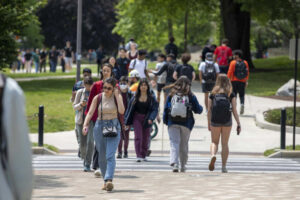NOVEMBER 13, 2023

international students flock to United States
Fueled by record numbers from India and other South Asian countries, the head count of international students at U.S. colleges and universities and in related training programs has surged at the fastest growth rate in more than 40 years and recovered almost all the ground lost during the coronavirus pandemic.
A report released Monday found 1,057,188 international students in the U.S. higher education system during the 2022-23 school year, up nearly 12 percent from the previous year. Not since the late 1970s has the total grown that much in one year. These students bring global perspectives to campuses and account for more than 5 percent of postsecondary enrollment in the United States.
The total from India reached 268,923, up 35 percent, according to the Open Doors report from the State Department and the Institute of International Education. That set a record for what is now the world’s most populous nation.
“The U.S. maintains a strong relationship with India on education, which I think is getting even stronger and even more connected between our governments and between the university sector and other stakeholders,” Marianne Craven, acting deputy assistant secretary of state for academic exchanges, told reporters recently. She said Indian students are drawn for many reasons, including “top-flight faculty in our colleges and universities.”
The report shows that most of these Indian students — nearly 166,000 — are seeking master’s degrees or other advanced credentials. They are gravitating in large numbers to Texas, New York, California, Massachusetts and Illinois.
The University of Texas at Austin reports 1,248 Indians enrolled this fall, and the University of Maryland at College Park reports 1,589. The vast majority of Indians at both public flagship universities are graduate students.
India, the second-largest sender of students to the United States, is fast catching up to China. The Chinese total, 289,526 in 2022-23, was almost unchanged.
Other neighbors of India are showing huge growth. Nepal had more than 15,000 students at U.S. institutions in the past school year and Bangladesh more than 13,500. Both totals were up 28 percent. Pakistan had more than 10,100, up 16 percent.
The report shows a huge rebound of international higher education following the global public health crisis that struck in early 2020, disrupting flows of students to and from the United States and forcing most to take classes remotely. In the 2019-20 school year, the United States hosted about 1,075,000 international students. The number plummeted in the next school year, to about 914,000, before it began to recover.
Monday’s report counted nearly 300,000 newly enrolled international students in 2022-23, up 14 percent from the previous year.
The international student count includes undergraduate and graduate students — with a few enrolled online from abroad — as well as a significant number who stay after finishing their studies under a temporary work program called “optional practical training.”
They bring crucial revenue to colleges and universities, often paying full tuition or close to it, and the federal government estimates they pump nearly $38 billion a year into the economy. They also provide enduring evidence of the global prestige of U.S. institutions devoted to teaching and research.
In addition to the Open Doors report, which analyzes data from more than 2,800 colleges and universities, a companion survey of about 630 schools shows the growth trend continuing this fall. That survey indicates there are about 8 percent more international students in this school year, compared to the last one, who are either taking classes or in the work-training program.
The data released Monday shows the evolving origins of international students. Ghana, with more than 6,400 students at U.S. institutions as of 2022-23, is now among the 25 countries that send the most students.
Nepal sends more students to the United States than Mexico, the United Kingdom and Germany. Growth of international students from sub-Saharan Africa (up 18 percent year over year) outpaces Asia (14 percent), Europe (8 percent) and Latin America and the Caribbean (5 percent).
Many factors influence which countries send how many students. Countries with scarce or relatively modest higher-education capacity often find that middle class and affluent families want their children to study overseas. And the United States has long been a preeminent destination for higher education.
“Made in the USA is something that these students and families want on their diplomas,” said Allan E. Goodman, chief executive of the Institute of International Education.
Courtesy: The Washington Post











































































































